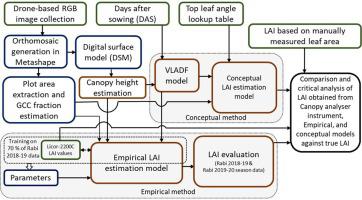International Journal of Applied Earth Observation and Geoinformation ( IF 7.5 ) Pub Date : 2020-12-22 , DOI: 10.1016/j.jag.2020.102282 Rahul Raj , Jeffrey P. Walker , Rohit Pingale , Rohit Nandan , Balaji Naik , Adinarayana Jagarlapudi

|
Leaf Area Index (LAI) is one of the most important biophysical properties of a crop, used in detecting long-term water stress, estimating biomass, and identifying crop growth stage. Remote sensing based LAI estimation techniques perform well for early growth stages but tend to produce high error during the crop reproductive stage due to canopy closure. Moreover, estimation of the true LAI from individual leaf measurements remains a challenge. Consequently, two alternate methods have been developed and compared for estimating the LAI of a maize crop using top-of-canopy RGB images collected throughout the growing season using a hexacopter. Both methods used the RGB images to estimate the canopy height and the green-canopy cover together with a ‘vertical leaf area distribution factor’ (VLADF) from allometric relations (using crop height from RBG images and days after sowing). The first method used an empirical approach to estimate the LAI from training a linear function of the above inputs to Licor canopy analyser values of LAI. The method was trialled for a research farm located in a semi-arid area of southern peninsula India and found to have validation results with an of 0.84 and RMSE of 0.36 for the unused portion of the Rabi (post-monsoon) season data of 2018–19, and of 0.77 and RMSE of 0.45 for the Rabi 2019–20 season data when compared with Licor LAI values. While seemingly acceptable, the Licor canopy analyser gives a foliage area index and so the accuracy of this model was very low ( of 0.56 and RMSE of 1.34) when evaluated with true LAI from manual measurements of the leaf area. Consequently, a refinement was introduced using only VLADF, green-canopy cover estimates from the RBG images, and a field measured top leaf angle. The output derived from this conceptual model had an of ~0.6 and RMSE of 0.73 when compared with the true LAI values. Importantly, the LAI from this conceptual model was found to be unaffected by canopy closure during the reproductive stage of the crop.
中文翻译:

使用冠层机载RGB图像估算叶面积指数
叶面积指数(LAI)是作物最重要的生物物理特性之一,用于检测长期的水分胁迫,估算生物量和确定作物的生长期。基于遥感的LAI估计技术在早期生长阶段表现良好,但由于树冠封闭,在作物繁殖阶段往往会产生高误差。而且,从各个叶片测量值估计真实的LAI仍然是一个挑战。因此,已经开发出了两种替代方法,并使用六旋翼飞机使用了在整个生长季节收集的树冠顶部RGB图像,比较了估计玉米作物的LAI的方法。两种方法都使用RGB图像来估计冠层高度和绿冠层覆盖以及“垂直叶面积分布因子”(VLADF)的异体关系(使用RBG图像中的作物高度和播种后的天数)。第一种方法使用经验方法从训练上述输入的线性函数到LAI的Licor冠层分析器值来估计LAI。该方法已在位于印度南部半岛半干旱地区的研究农场进行了试验,结果发现该方法的验证结果为 对于2018-19年度Rabi(季风后)季节数据的未使用部分为0.84,RMSE为0.36,以及 与Licor LAI值相比,Rabi 2019-20赛季数据为0.77,RMSE为0.45。尽管看上去可以接受,但Licor冠层分析仪给出了叶子面积指数,因此该模型的准确性非常低(当使用真正的LAI从叶面积的手动测量中进行评估时,其值为0.56和RMSE为1.34)。因此,仅使用VLADF,来自RBG图像的绿冠覆盖估计以及实地测得的顶叶角进行了改进。从此概念模型得出的输出具有与真实的LAI值相比,约为0.6,RMSE为0.73。重要的是,从该概念模型得出的LAI在作物的生殖阶段不受冠层关闭的影响。


























 京公网安备 11010802027423号
京公网安备 11010802027423号